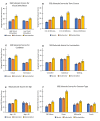Factors Associated With Virtual Reality Sickness in Head-Mounted Displays: A Systematic Review and Meta-Analysis
- PMID: 32300295
- PMCID: PMC7145389
- DOI: 10.3389/fnhum.2020.00096
Factors Associated With Virtual Reality Sickness in Head-Mounted Displays: A Systematic Review and Meta-Analysis
Abstract
The use of head-mounted displays (HMD) for virtual reality (VR) application-based purposes including therapy, rehabilitation, and training is increasing. Despite advancements in VR technologies, many users still experience sickness symptoms. VR sickness may be influenced by technological differences within HMDs such as resolution and refresh rate, however, VR content also plays a significant role. The primary objective of this systematic review and meta-analysis was to examine the literature on HMDs that report Simulator Sickness Questionnaire (SSQ) scores to determine the impact of content. User factors associated with VR sickness were also examined. A systematic search was conducted according to PRISMA guidelines. Fifty-five articles met inclusion criteria, representing 3,016 participants (mean age range 19.5-80; 41% female). Findings show gaming content recorded the highest total SSQ mean 34.26 (95%CI 29.57-38.95). VR sickness profiles were also influenced by visual stimulation, locomotion and exposure times. Older samples (mean age ≥35 years) scored significantly lower total SSQ means than younger samples, however, these findings are based on a small evidence base as a limited number of studies included older users. No sex differences were found. Across all types of content, the pooled total SSQ mean was relatively high 28.00 (95%CI 24.66-31.35) compared with recommended SSQ cut-off scores. These findings are of relevance for informing future research and the application of VR in different contexts.
Keywords: cybersickness; head-mounted display; simulator sickness; virtual environment; virtual reality.
Copyright © 2020 Saredakis, Szpak, Birckhead, Keage, Rizzo and Loetscher.
Figures



References
-
- Aged Care Virtual Reality (2018). VR Programs for Health Benefits. Retrieved from http://www.agedcarevirtualreality.com/ (accessed December 17, 2018).
-
- Arcioni B., Palmisano S., Apthorp D., Kim J. (2018). Postural stability predicts the likelihood of cybersickness in active HMD-based virtual reality. Displays 58, 3–11. 10.1016/j.displa.2018.07.001 - DOI
Publication types
LinkOut - more resources
Full Text Sources
Medical
Miscellaneous

